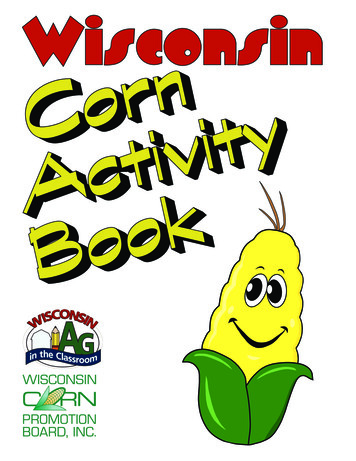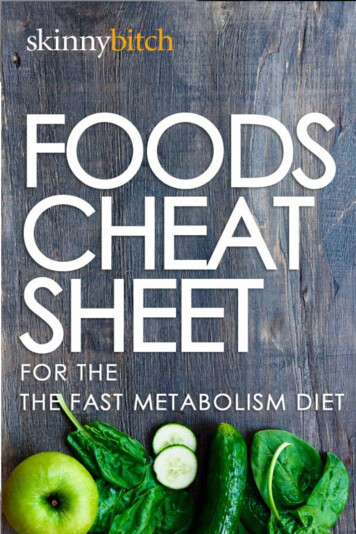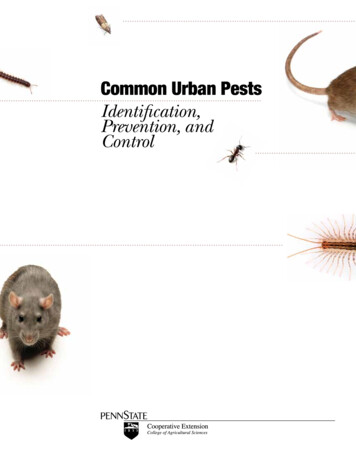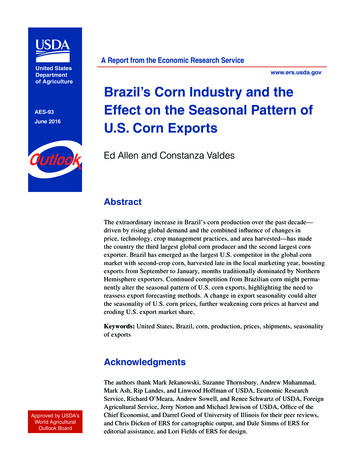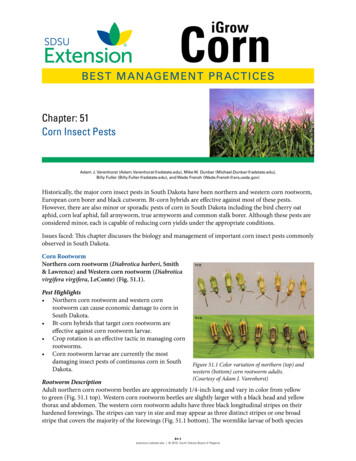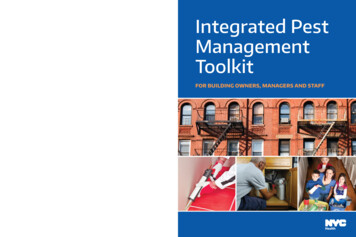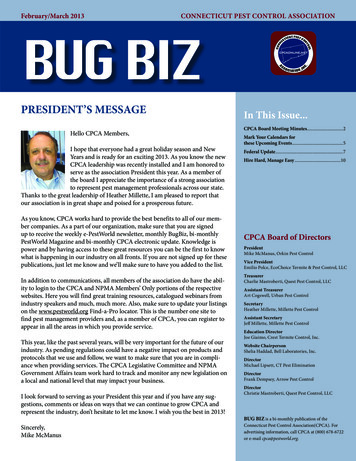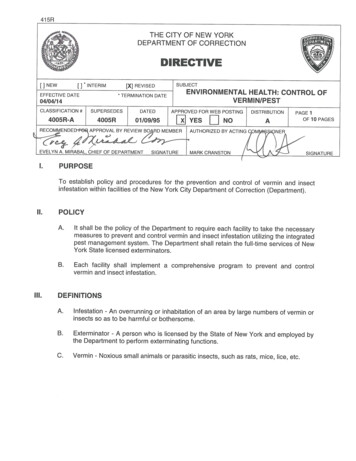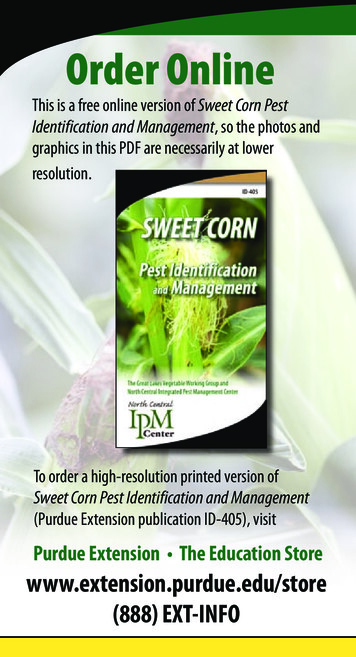
Transcription
Order OnlineThis is a free online version of Sweet Corn PestIdentification and Management, so the photos andgraphics in this PDF are necessarily at lowerresolution.To order a high-resolution printed version ofSweet Corn Pest Identification and Management(Purdue Extension publication ID-405), visitPurdue Extension The Education Storewww.extension.purdue.edu/store(888) EXT-INFO
ID-405SWEET CORNPest Identificationand ManagementThe Great Lakes Vegetable Working Group andNorth Central Integrated Pest Management Center
This guide was created by the Great Lakes VegetableWorking Group and North Central Integrated PestManagement Center.The Great Lakes Vegetable Working Group is acommunication network for vegetable specialiststhroughout the Great Lakes region that addresses currentpriorities for growers and the vegetable industry. Membersof the group represent the following universities:Cornell UniversityUniversity of GuelphUniversity of IllinoisUniversity of KentuckyMichigan State UniversityUniversity of MinnesotaOhio State UniversityPennsylvania State UniversityPurdue UniversityUniversity of WisconsinMore information is available at:http://glvwg.ag.ohio-state.edu.The North Central Integrated Pest ManagementCenter is one of four centers in a national networkestablished to strengthen the USDA’s connection withproduction agriculture, research, and extension programsthroughout the United States.More information is available at www.ncipmc.org.2
Contributors to this guide include:Ohio State UniversityJim Jasinski, Robert Precheur, and Celeste WeltyCornell UniversityPaul CurtisUniversity of GuelphDarren RobinsonUniversity of IllinoisJerald Pataky and Richard WeinzierlUniversity of MinnesotaRoger Becker and Vince FritzPennsylvania State UniversityMichael Orzolek3
PrefaceThis Sweet Corn Pest Identification and Management pocketguide is a quick, colorful, and handy reference for sweetcorn growers, extension educators, crop consultants, andindustry field representatives who work in the NorthCentral Region and Ontario, Canada.The information presented here is brief and cannot includeevery possible pest or management option in fresh marketor processing sweet corn production in these areas. So, thisguide focuses on the most critical pests and managementoptions.This guide contains pictures, basic descriptions, andmanagement tips of economically important weeds,diseases, pest insects, and vertebrates. It also includessections that describe beneficial insects, common types ofherbicide injury, and general horticultural practices.Reference to products in this publication is not intended tobe an endorsement to the exclusion of others that may besimilar. Persons using such products assume responsibilityfor their use in accordance with current directions of themanufacturer. Due to rapid changes in pesticide labels,always seek product recommendations from publicationsspecific to your state or province.4
AcknowledgementsThe development of this regional guide would not havebeen possible without the devotion and expertise ofmany individuals and the support of the North CentralIntegrated Pest Management Center. Images for thisguide were provided by the authors, plus:Marita Cantwell, Galen Dively, Doug Doohan, BruceEisley, Joel Felix, Chris Gunter, Ron Hammond, TimHartz, Louise Jackson, Pat Lipps, Sally Miller, JohnObermeyer, Marlin E. Rice, Elaine Roddy, Kurt Schulbach,Dave Shetlar, Richard Smith, Trevor V. Suslow, DarrylWarncke, Purdue Extension Entomology, the 2008 CornellIntegrated Crop and Pest Management Guidelines forVegetable Crops, the 2008 Mid-Atlantic States CommercialVegetable Production Recommendations, the 2008-2009New England Vegetable Management Guide, the 2008Ohio Vegetable Production Guide.5
6
Table of ContentsDiagnostic Laboratories . . . . . . . . . . . . . . . . . . . . . . . . . . . . 11Production and Culture . . . . . . . . . . . . . . . . . . . . . . 13Sweet Corn Genotypes . . . . . . . . . . . . . . . . . . . . . . . . . . . . 13Isolation Requirements . . . . . . . . . . . . . . . . . . . . . . . . . . . . 14Planting . . . . . . . . . . . . . . . . . . . . . . . . . . . . . . . . . . . . . . . . . 15Plastic Mulches . . . . . . . . . . . . . . . . . . . . . . . . . . . . . . . . . . . 15Row Covers . . . . . . . . . . . . . . . . . . . . . . . . . . . . . . . . . . . . . . . 16Plant Spacing . . . . . . . . . . . . . . . . . . . . . . . . . . . . . . . . . . . . . 16Plant Populations . . . . . . . . . . . . . . . . . . . . . . . . . . . . . . . . . 16Soil pH and Lime . . . . . . . . . . . . . . . . . . . . . . . . . . . . . . . . . 17Recommended Nutrients Based on Soil Tests . . . . . . . . . . 17Zinc . . . . . . . . . . . . . . . . . . . . . . . . . . . . . . . . . . . . . . . . . . . . . 17Boron . . . . . . . . . . . . . . . . . . . . . . . . . . . . . . . . . . . . . . . . . . . 17Pre-Sidedress Soil Nitrate Test . . . . . . . . . . . . . . . . . . . . . . . 17Petiole Sap Testing . . . . . . . . . . . . . . . . . . . . . . . . . . . . . . . . 19Typical Mineral Deficiency Symptoms . . . . . . . . . . . . . . . . 21Phosphorus Deficiency . . . . . . . . . . . . . . . . . . . . . . . . . . . . . 21Potassium Deficiency . . . . . . . . . . . . . . . . . . . . . . . . . . . . . . 22Harvesting . . . . . . . . . . . . . . . . . . . . . . . . . . . . . . . . . . . . . . . 22Post Harvest . . . . . . . . . . . . . . . . . . . . . . . . . . . . . . . . . . . . . . 23Weed Biology and Seedling Identification . . . 24Broadleaf Weeds . . . . . . . . . . . . . . . . . . . . . . . . . . . . . . . . 24Apple of Peru . . . . . . . . . . . . . . . . . . . . . . . . . . . . . . . . . . . 24Chickweed . . . . . . . . . . . . . . . . . . . . . . . . . . . . . . . . . . . . . 25Common Cocklebur . . . . . . . . . . . . . . . . . . . . . . . . . . . . . 25Common Groundsel . . . . . . . . . . . . . . . . . . . . . . . . . . . . . 26Clammy Groundcherry . . . . . . . . . . . . . . . . . . . . . . . . . . . 267
Common Mallow . . . . . . . . . . . . . . . . . . . . . . . . . . . . . . . 27Common Lambsquarters . . . . . . . . . . . . . . . . . . . . . . . . . 27Common Ragweed . . . . . . . . . . . . . . . . . . . . . . . . . . . . . . 28Common Purslane . . . . . . . . . . . . . . . . . . . . . . . . . . . . . . 28Eastern Black Nightshade . . . . . . . . . . . . . . . . . . . . . . . . 29Giant Ragweed . . . . . . . . . . . . . . . . . . . . . . . . . . . . . . . . . 29Hairy Galinsoga . . . . . . . . . . . . . . . . . . . . . . . . . . . . . . . . 30Henbit . . . . . . . . . . . . . . . . . . . . . . . . . . . . . . . . . . . . . . . . 30Horsenettle . . . . . . . . . . . . . . . . . . . . . . . . . . . . . . . . . . . . 31Redroot Pigweed . . . . . . . . . . . . . . . . . . . . . . . . . . . . . . . 31Smooth Groundcherry . . . . . . . . . . . . . . . . . . . . . . . . . . . 32Velvetleaf . . . . . . . . . . . . . . . . . . . . . . . . . . . . . . . . . . . . . . 32Wild Buckwheat . . . . . . . . . . . . . . . . . . . . . . . . . . . . . . . . 33Grass Weeds . . . . . . . . . . . . . . . . . . . . . . . . . . . . . . . . . . . . 34Barnyardgrass . . . . . . . . . . . . . . . . . . . . . . . . . . . . . . . . . . 34Fall Panicum . . . . . . . . . . . . . . . . . . . . . . . . . . . . . . . . . . . 34Field (Longspine) Sandbur . . . . . . . . . . . . . . . . . . . . . . . 35Giant Foxtail . . . . . . . . . . . . . . . . . . . . . . . . . . . . . . . . . . . 35Green Foxtail . . . . . . . . . . . . . . . . . . . . . . . . . . . . . . . . . . . 35Johnsongrass . . . . . . . . . . . . . . . . . . . . . . . . . . . . . . . . . . 36Large Crabgrass . . . . . . . . . . . . . . . . . . . . . . . . . . . . . . . . 36Quackgrass . . . . . . . . . . . . . . . . . . . . . . . . . . . . . . . . . . . . 36Shattercane . . . . . . . . . . . . . . . . . . . . . . . . . . . . . . . . . . . . 37Smooth Crabgrass . . . . . . . . . . . . . . . . . . . . . . . . . . . . . . 37Wild Proso Millet . . . . . . . . . . . . . . . . . . . . . . . . . . . . . . . 37Wirestem Muhly . . . . . . . . . . . . . . . . . . . . . . . . . . . . . . . . 38Witchgrass . . . . . . . . . . . . . . . . . . . . . . . . . . . . . . . . . . . . . 38Woolly Cupgrass . . . . . . . . . . . . . . . . . . . . . . . . . . . . . . . . 38Yellow Foxtail . . . . . . . . . . . . . . . . . . . . . . . . . . . . . . . . . . 398
Herbicide Injury Diagnosis . . . . . . . . . . . . . . . . . . . 40Acetolactate Synthase Inhibitors . . . . . . . . . . . . . . . . . . . . 40Auxin or Growth Regulators . . . . . . . . . . . . . . . . . . . . . . . . 41Bleaching Herbicides . . . . . . . . . . . . . . . . . . . . . . . . . . . . . . 42Chloroacetamides . . . . . . . . . . . . . . . . . . . . . . . . . . . . . . . . 43Contact Herbicides . . . . . . . . . . . . . . . . . . . . . . . . . . . . . . . . 44Dinitroanilines . . . . . . . . . . . . . . . . . . . . . . . . . . . . . . . . . . . 45EPSP Inhibitors . . . . . . . . . . . . . . . . . . . . . . . . . . . . . . . . . . . 46Glutamine Synthetase Inhibitors . . . . . . . . . . . . . . . . . . . . 47Photosynthesis Inhibitors . . . . . . . . . . . . . . . . . . . . . . . . . . 48Pest Insects and Slugs . . . . . . . . . . . . . . . . . . . . . . . . 49Armyworm . . . . . . . . . . . . . . . . . . . . . . . . . . . . . . . . . . . . . . . 49Black Cutworm . . . . . . . . . . . . . . . . . . . . . . . . . . . . . . . . . . . 51Common Stalk Borer . . . . . . . . . . . . . . . . . . . . . . . . . . . . . . 53Corn Earworm . . . . . . . . . . . . . . . . . . . . . . . . . . . . . . . . . . . . 54Corn Flea Beetle . . . . . . . . . . . . . . . . . . . . . . . . . . . . . . . . . . 56Corn Leaf Aphid . . . . . . . . . . . . . . . . . . . . . . . . . . . . . . . . . . . 57Corn Rootworms (Larvae) . . . . . . . . . . . . . . . . . . . . . . . . . . 58Corn Rootworms (Adult Beetles) . . . . . . . . . . . . . . . . . . . . . 60European Corn Borer . . . . . . . . . . . . . . . . . . . . . . . . . . . . . . . 62Fall Armyworm . . . . . . . . . . . . . . . . . . . . . . . . . . . . . . . . . . . 64Japanese Beetle . . . . . . . . . . . . . . . . . . . . . . . . . . . . . . . . . . 66Sap Beetles . . . . . . . . . . . . . . . . . . . . . . . . . . . . . . . . . . . . . . 67Seedcorn Maggot . . . . . . . . . . . . . . . . . . . . . . . . . . . . . . . . . 69Slugs . . . . . . . . . . . . . . . . . . . . . . . . . . . . . . . . . . . . . . . . . . . 70Western Bean Cutworm . . . . . . . . . . . . . . . . . . . . . . . . . . . . 72White Grubs . . . . . . . . . . . . . . . . . . . . . . . . . . . . . . . . . . . . . . 74Wireworms . . . . . . . . . . . . . . . . . . . . . . . . . . . . . . . . . . . . . . 769
Beneficial Insects . . . . . . . . . . . . . . . . . . . . . . . . . . . . . 77Ladybugs . . . . . . . . . . . . . . . . . . . . . . . . . . . . . . . . . . . . . . . . 77Green and Brown Lacewings . . . . . . . . . . . . . . . . . . . . . . . 78Parasitoid Wasps . . . . . . . . . . . . . . . . . . . . . . . . . . . . . . . . . . 79Syrphid or Hover Flies . . . . . . . . . . . . . . . . . . . . . . . . . . . . . 79Insidious Flower Bug . . . . . . . . . . . . . . . . . . . . . . . . . . . . . . 80Damsel Bug (Nabids) . . . . . . . . . . . . . . . . . . . . . . . . . . . . . . 80Diseases . . . . . . . . . . . . . . . . . . . . . . . . . . . . . . . . . . . . . . . 81Anthracnose Leaf Blight . . . . . . . . . . . . . . . . . . . . . . . . . . . . 81Anthracnose Stalk Rot . . . . . . . . . . . . . . . . . . . . . . . . . . . . . 82Common Rust . . . . . . . . . . . . . . . . . . . . . . . . . . . . . . . . . . . . 83Common Smut . . . . . . . . . . . . . . . . . . . . . . . . . . . . . . . . . . . 84Crazy Top . . . . . . . . . . . . . . . . . . . . . . . . . . . . . . . . . . . . . . . . 85Gray Leaf spot . . . . . . . . . . . . . . . . . . . . . . . . . . . . . . . . . . . . 86Maize Chlorotic Dwarf Virus . . . . . . . . . . . . . . . . . . . . . . . . 87Maize Dwarf Mosaic Virus . . . . . . . . . . . . . . . . . . . . . . . . . . 88Northern Corn Leaf Blight . . . . . . . . . . . . . . . . . . . . . . . . . . 89Northern Corn Leaf Spot . . . . . . . . . . . . . . . . . . . . . . . . . . . 90Seedling Blights . . . . . . . . . . . . . . . . . . . . . . . . . . . . . . . . . . 91Southern Corn Leaf Blight . . . . . . . . . . . . . . . . . . . . . . . . . . 92Stewart’s Bacterial Wilt . . . . . . . . . . . . . . . . . . . . . . . . . . . . 93Vertebrate Pests . . . . . . . . . . . . . . . . . . . . . . . . . . . . . . 95Blackbirds . . . . . . . . . . . . . . . . . . . . . . . . . . . . . . . . . . . . . . . 95Deer . . . . . . . . . . . . . . . . . . . . . . . . . . . . . . . . . . . . . . . . . . . . 97Raccoons . . . . . . . . . . . . . . . . . . . . . . . . . . . . . . . . . . . . . . . 10010
Diagnostic LaboratoriesTo properly identify weeds, insects, or diseases, contact thediagnostic laboratory in your state or province for propersubmission procedures and current fees. The contactinformation for selected labs appears below:IllinoisUniversity of Illinois Plant Clinic(217) Purdue Plant and Pest Diagnostic Laboratory(765) 494-7071www.ppdl.purdue.eduKentuckyUniversity of Kentucky Plant Disease DiagnosticLaboratories(859) tension/pdd lab.htmlMichiganMichigan State University Diagnostic Services(517) 355-4536www.pestid.msu.eduMinnesotaUniversity of Minnesota Plant Disease Clinic(612) 625-1275http://pdc.umn.edu11
New YorkCornell University Plant Disease Diagnostic Clinic(607) 255-7850 orhttp://plantclinic.cornell.eduOhioThe C. Wayne Ellett Plant and Pest Diagnostic Clinic(614) 292-5006http://ppdc.osu.eduOntario, CanadaUniversity of Guelph Laboratory Services(519) vania State University Plant Disease Clinic(814) 865-2204www.ppath.cas.psu.edu/Plant Disease Clinic.htmWisconsinUniversity of Wisconsin Plant Disease Diagnostics Clinicand Insect Diagnostic Lab(608) wisc.edu/entodiag.html12
Production and CultureSweet Corn GenotypesSweet corn varieties are categorized by their genotypes.The most common varieties are:Normal or sugary (su) — Standard hybrid sweet corn isa mutant type of corn that differs from field or dent corn bymutation at the sugary (se) locus. The standard hybridsweet corn accumulates about two times more sugar thanfield corn. Refrigeration after harvest is essential tomaintain qualitySugar enhanced (se) — There are two distinct groups ofcultivars containing the se gene. There are thehomozygous se (or se ) cultivars that have higher sugarlevels in 100 percent of their kernels. There also areheterozygous se cultivars that have higher sugar levels inonly 25 percent of their kernels; the other 75 percentcontain the normal su gene with lower sugar levels.Refrigeration after harvest is essential to maintain quality.Supersweet or shrunken (sh2) — The sugar content ofkernels is twice as high as standard su sweet corn. It isessential to isolate these varieties from all other corntypes. These varieties have a slow sugar conversion tostarch, so ear quality at harvest will hold for seven to 10days. Refrigeration after harvest will help extend quality.13
Other varieties include: Insect protected (Bacillus thuringiensis (Bt) breeds (se)). Sweet breeds (su.se and sh2). Synergistic or sweet genes (su.se and sh2). Improved supersweets, augmented supersweets (sh2).Isolation RequirementsTo avoid starchy kernels, sh2 varieties need to be isolated atleast 300 feet from non-sh2 varieties or, planted so there isat least 12 days between silking of neighboring varieties.Su and se varieties can be planted side-by-side withoutthis occurring. All sweet corn must be isolated from fieldand popcorn varieties.Here are some general rules of thumb for isolating thesegenotypes: Grow all normal, se varieties (heterozygous andhomozygous, like Table Sweet) apart from sh2 andaugmented shrunken varieties. Grow all sh2 (100 percent supersweet) varieties apartfrom su, all se, and all su.se varieties. Grow all su.se varieties (Sweet Breed, Triple Sweet,Syngergistic-homozygous se with Bt) apart from all sh2and augmented shrunken varieties. Grow all augmented shrunken varieties (Gourmet Sweet,Multisweet, Xtra Tender) apart from su, all se, and allsu.se types. Isolate all sweet corn varieties from field, ornamental,and popcorn varieties. Su and se varieties can be planted side-by-side.14
PlantingPlastic MulchesUsing clear, plastic mulch will speed the maturity of earlyplantings. When using plastic mulches, seed two weeksearlier than usual in double rows spaced 14 to 16 inchesapart on 5- to 6-foot centers. In-row-spacing should be 8 to12 inches between plants. Apply herbicide and cover with1 to 1.25 mil-thick clear plastic mulch that is 4 feet wide.Keep the plastic over plants for approximately 30 days oruntil daytime temperatures consistently exceed 75 F. Atthat time, cut the plastic and remove it from the field,usually when plants are 6 to 12 inches tall. Plant coldtolerant varieties to avoid uneven stands and uneven vigor.Clear, plastic mulch speeds the maturity of early plantings.15
Row CoversAnother approach to accelerating maturity is to apply apolyester or polypropylene row cover (floating) afterplanting. Although this method does not increase soiltemperatures as quickly as plastic mulch, using row coversdoes have advantages. Floating row covers allow the useof standard row spacing, pose less danger of plant injuryfrom high temperatures, are easier to use, and allow forthe reuse of row covers for several seasons.Sh2 varieties are also more difficult to establish than seand su types. Sh2 varieties germinate poorly below 60 Fand rough handling easily damages their seeds.Plant SpacingRow spacing for most sweet corn varieties is commonly 30to 36 inches between rows, with plants spaced 8 to 12inches within the row. Closer in-row spacing may be usedin early plantings, while wider in-row spacing is used forlate plantings.Plant PopulationsThe recommended plant population of sweet corn isbetween 15,000 to 21,000 plants per acre. Higherpopulations require more water and fertilizer during thegrowing season to maintain ear size and increase thenumber of marketable ears per acre.16
Soil pH and LimeMaintain a target soil pH of 6.5 and lime fields when thesoil pH falls below 6.0. If soil magnesium is less than 100pounds per acre, use high magnesium or dolomitic lime toadjust pH.Recommended NutrientsBased on Soil TestsIf using drip irrigation to provide water to the corn crop,apply 40 pounds of nitrogen (N) per acre injected into thedrip tape in 10 to 15 pounds of actual N per application.Use water soluble forms of granular or liquid fertilizer.ZincIf the soil test for zinc is between 0.5 and 1 pound per acre,broadcast 0.5 pound of zinc per acre for long-term benefits.If the zinc in the soil is less than 0.5 pound per acre, apply1 pound of zinc per acre. When zinc levels are marginal,applying 1 pound of zinc in the fertilizer band may be helpful.BoronApply 1 to 2 pounds of boron per acre with broadcastfertilizer.Pre-Sidedress Soil Nitrate Test (PSNT)The pre-sidedress soil nitrate test (PSNT) is an in-seasonsoil test that provides information about the soil’s Nsupplying capacity. Unlike a traditional soil test, the soilsample for a PSNT is collected from the top 12 inches of17
181040-60040040040040040K2O Pounds/AcreSoil K LevelLowMed.High120804080400Total RecommendedBroadcast and disk-in.Band place withplanter.Sidedress when corn is6-12 inches high.1CommentsA second sidedressing could replace the preplant, broadcast N application if it is made before corn is 12 inches tall.This is preferable on leachable soils.40P2O5 Pounds/AcreSoil P LevelLowMed.High12080408040040120-14040N Pounds/AcreRecommended Nutrients Based on Soil Tests
soil when corn plants are 12 inches tall. When the fertilizerreleases mineral N into the soil, it accumulates as nitrate(NO3). The concentration of soil NO3 increases during thespring and generally peaks at about the 12-inch corngrowth stage. When plants reach this size they rapidlytake up and remove NO3 from the soil. The PSNT,therefore, measures the soil NO3 concentration at a keygrowth stage.Growers may use the PSNT to determine whether theyneed sidedress N. The test is effective for sweet corn grownon soils with loamy-textures, with high organic matter, orwhere manure has been applied. The PSNT determines theN available from manures, cover crops, and previous crops.Contact your local extension educator for more detailsconcerning specific test results.Petiole Sap TestingAnother method for testing NO3 levels in the soil involvescollecting petiole sap from corn plants for analysis with aCardy meter. Because plant tissue testing is destructive,soil testing is preferred for routine analysis. However,tissue testing is useful when more information on theplant nutrient status is required.To test petiole sap, collect the 6-inch pieces from the mainstalks of a representative sample of sweet corn plants in afield (about 15 to 20 plants). Cut a thin section from thecenter of each of stalk and express the juice from thesesmall sections for analysis. Pour a small amount of the sap19
from the cup onto the sensor of the Cardy meter foranalysis. This test can be conducted during the entireseason, with no additional N fertility needed if test resultsfor NO3-N are in the 600 to 700 ppm range.Chlorophyll meters also can be used to help determinenitrogen needs.20
Typical MineralDeficiency SymptomsPhosphorus DeficiencySymptoms: Purpling of older leaves, usually on youngplants.Causes: Acid and cold soils.21
Potassium DeficiencySymptoms: Leaf margins are tan, scorched, or havenecrotic spots.Causes: Acid soils.HarvestingUnder normal temperatures, most sweet corn varietiesreach maturity 18 to 21 days after silking. Supersweets(sh2) have a wider “harvest window” than normal orsugary (su) and sugar enhanced (se) varieties.22
Sweet corn is considered mature for fresh marketconsumption when: The pollination silks are dried. The kernels are still immature but are plump andappear “milky,” not doughy, when squeezed.At this point the water content of su kernels is 70 percentto 75 percent; the water content of sh2 is 77 percent to 78percent.Fresh market sweet corn quality is based on the followingcriteria: Freshness. Uniform appearance. Uniform and well-filled rows. Plumpness of kernels. Milky kernel contents. Freedom from damage and defects, includingdiscoloration, harvest injury, worm damage, liveinsects, and decaying silks or kernels.Post HarvestStore harvested corn between 32 F and 40 F at 98 percentrelative humidity. Sweet corn is generally hydrocooled andpacked with ice or top-iced. After thorough cooling andicing, be sure storage and transit temperatures holdslightly above 32 F (0 C).23
Weed Biology and SeedlingIdentificationBroadleaf WeedsApple of PeruFamily: Nightshade (Solanaceae).Life Cycle: Annual that reproduces by seed.24
ChickweedFamily: Pink (Caryophyllaceae).Life Cycle: Annual that reproduces by seed.Common CockleburFamily: Aster (Asteraceae).Life Cycle: Annual that reproduces by seed.25
Common GroundselFamily: Aster (Asteraceae).Life Cycle: Annual that reproduces by seed.Clammy GroundcherryFamily: Nightshade (Solanaceae).Life Cycle: Perennial that reproduces by seed and rhizomes.26
Common MallowFamily: Mallow (Malvaceae).Life Cycle: Annual or biennial that reproduces by seed.Common LambsquartersFamily: Goosefoot (Chenopodiaceae).Life Cycle: Annual that reproduces by seed.27
Common RagweedFamily: Aster (Asteraceae).Life Cycle: Annual that reproduces by seed.Common PurslaneFamily: Purslane (Portulacaceae).Life Cycle: Summer annual that reproduces by seed.28
Eastern Black NightshadeFamily: Nightshade (Solanaceae).Life Cycle: Annual that reproduces by seed. Rarely, ashort-lived perennial.Giant RagweedFamily: Aster (Asteraceae).Life Cycle: Annual that reproduces by seed.29
Hairy GalinsogaFamily: Aster or Sunflower (Asteraceae).Life Cycle: Annual that reproduces by seed.HenbitFamily: Mint (Lamiaceae).Life Cycle: Winter annual that reproduces by seed androoting stems.30
HorsenettleFamily: Nightshade (Solanaceae).Life Cycle: Perennial that reproduces by seed and rhizomes.Redroot PigweedFamily: Amaranth (Amaranthaceae).Life Cycle: Annual that reproduces by seed.31
Smooth GroundcherryFamily: Nightshade (Solanaceae).Life Cycle: Perennial that reproduces by seed and rhizomes.VelvetleafFamily: Mallow (Malvaceae).Life Cycle: Annual that reproduces by seed.32
Wild BuckwheatFamily: Smartweed (Polygonaceae).Life Cycle: Annual that reproduces by seed.33
Grass WeedsAll grasses in this section are from the family Poaceae.BarnyardgrassSheath: Smooth and flattened.Blade: Rough margin andprominent mid-vein.Ligule: None.Auricles: None.Life Cycle: Annual thatreproduces by seed.Fall PanicumSheath: Slightly flattened,smooth to occasionally hairy.Blade: Smooth, dull above, glossybelow, underside may have hair.Ligule: Short fringe of hairs.Auricles: None.Life Cycle: Annual thatreproduces by seed.34
Field (Longspine)SandburSheath: Flattened with little orno hair, fringe of hairs on sheathmargin at the leaf collar.Blade: Little or no hair, twisted.Ligule: Short fringe of hairs.Auricles: None.Life Cycle: Annual thatreproduces by seed.Giant FoxtailSheath: Round with hair onmargins.Blade: Short hairs cover theupper surface.Ligule: Fringe of hairs.Auricles: None.Life Cycle: Annual thatreproduces by seed.Green FoxtailSheath: Round with hair onmargins.Blade: Hairless.Ligule: Fringe of hairs.Auricles: None.Life Cycle: Annual thatreproduces by seed.35
JohnsongrassSheath: Rounded to flattenedand smooth.Blade: Smooth to sparsely hairyabove and smooth below.Ligule: Long, rounded, andpossibly hair-like on tip.Auricles: None.Life Cycle: Perennial thatreproduces by seed and rhizomes.Large CrabgrassSheath: Flattened with longscattered hairs.Blade: Sparse hairs above andbelow.Ligule: Long, membranous withnotched margins.Auricles: None.Life Cycle: Annual thatreproduces by seed.QuackgrassSheath: Rounded and smooth tosparsely hairy.Blade: Rough above, below, andon the margins.Ligule: Short and membranous.Auricles: Long, slender, clasping.Life Cycle: Perennial thatreproduces by seed and rhizomes.36
ShattercaneSheath: Rounded and smooth.Blade: Smooth but occasionallywith spare hairs above.Ligule: Long, membranous, androunded. May be jagged or hairlike on tip.Auricles: None.Life Cycle: Annual thatreproduces by seed.Smooth CrabgrassSheath: Flattened with asmooth margin.Blade: Long hairs near the liguleand a rough margin.Ligule: Long, membranous, androunded.Auricles: None.Life Cycle: Annual thatreproduces by seed.Wild Proso MilletSheath: Slightly flat with dense,stiff hairs that stick straight out.Blade: Dense, stiff hairs aboveand belowLigule: Short fringe of hairs.Auricles: None.Life Cycle: Annual thatreproduces by seed.37
Wirestem MuhlySheath: Flattened and smooth.Blade: Rough above, below, andon the margins.Ligule: Short and membranouswith toothed margins.Auricles: None.Life Cycle: Perennial thatreproduces by seed and rhizomes.WitchgrassSheath: Slightly flat with dense,soft hairs.Blade: Dense, soft hairs aboveand below, midrib is white andprominent.Ligule: Short fringe of hairs.Auricles: None.Life Cycle: Annual thatreproduces by seed.Woolly CupgrassSheath: Slightly flat and denselyhairy.Blade: Dark green, soft hairs,margin distinctly wavy on one side.Ligule: Short fringe of hairs.Auricles: None.Life Cycle: Annual thatreproduces by seed.38
Yellow FoxtailSheath: Flat, smooth margins.Blade: A few long hairs near thebase.Ligule: Fringe of hairs.Auricles: None.Life Cycle: Annual thatreproduces by seed.39
Herbicide Injury DiagnosisHerbicides can drift, carry over, or injure the crop directlysprayed. Diagnosing herbicide injury can help determinethe source of injury. Remember, herbicide injuries oftenresemble other kinds of injury (environmental, mechanical,insect predation), so be sure to correctly diagnose any injury.Herbicide injury symptoms can be categorized by theproduct’s class or mode of action. The most commonherbicide classes and the injury symptoms they cause aredescribed in more detail on the following pages.Acetolactate Synthase InhibitorsCommon (Trade) Names: nicosulfuron (Accent ),nicosulfuron isoxadifen-ethyl (Accent Gold ),imazethapyr (Pursuit ), and chloromuron-ethyl (Classic ).Symptoms: Yellowing and discolored leaves or bleachingnear the whorls, stunting of seedlings, onion-leafing, andpurpling of the stem or leaves. Herbicide carryover mayresult in shortening of secondary roots, causing the rootsto look like a bottlebrush.40
Auxin or Growth RegulatorsCommon (Trade) Names: 2,4-D, dicamba (Banvel ),clopyralid (Stinger ), dicamba diflufenzopyr (Distinct ),and dicamba diflufenzopyr isoxadifen-ethyl (Status ).Symptoms: Rolled “buggy-whip” whorls and twisted orflattened brace roots that do not grow into the soil tosupport the plant.41
Bleaching HerbicidesCommon (Trade) Names: tembotrione isoxadifenethyl (Laudis ), topramezone (Impact ), clomazone(Command ), and mesotrione (Callisto ).Symptoms: Bleached leaves develop between the 2-leafand 4-leaf stages on sensitive hybrids, up to 7-leaf stage onless sensitive hybrids. Leaf bleaching is more pronouncednear the midrib, and the bases of leaves may turn purple.42
ChloroacetamidesCommon (Trade) Names: s-metolachlor (Dual IIMagnum ), acetochlor (Harness , Surpass ), anddimethenamid-p (Outlook ).Symptoms: Ruptured coleoptiles leafing outunderground, shortened leaves, leaf tips stick and fail tounfurl (laddering, onio
4 Preface This Sweet Corn Pest Identification and Management pocket guide is a quick, colorful, and handy reference for sweet corn growers, extension educators, crop consultants, and industry field representatives who work in the North
